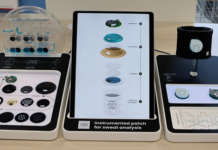As the world moves towards energy-efficient and environmentally-friendly technologies, the once simple smart self-service kiosks are now transforming to advanced, green-powered systems which use energy harvesting and Internet of Things (IoT) to provide super low-power uptime. Such kiosks, which are vital in industries like retail, hospitality, and transportation, are being supplied with energy from clean sources, thus, their performance is being improved while the necessity for conventional power sources is being lowered. The article states that energy harvesting meets IoT, and it elaborates on the way these innovations are changing the face of smart self-service kiosks.
The Rise of Smart Self-Service Kiosks
The use of self-service kiosks is a major factor in the change of various markets and industries. Through these easy-to-operate terminals, customers get quick and efficient interactions, and companies save on staff. Such instruments are endowed with a great number of capabilities, for instance, they can perform transactions and collect data, and are normally placed in locations where there are many people like malls, airports, and restaurants. Creators of these gadgets and the companies that use them are ready to find such solutions that will not only make the machines more intelligent but also less power-consuming if one looks at the continuous demand for environmental protection and energy-saving.
Energy Harvesting: The Key to Ultra-Low-Power Operations
Energy harvesting takes energy from nature such as the sun and changes it to power. This makes self-service kiosks able to work on their own, thus the time of operation is increased and expenses are lowered.
Key benefits of energy harvesting for smart kiosks include:
- Sustainability: Essentially, kiosks emit less CO2 to the atmosphere and thus are less responsible for the carbon footprint associated with total kiosk operations.
- Cost Efficiency: The business sector can cut down on electricity consumption through the use of energy harvesting devices, hence making the operation of kiosks more profitable in the long run.
- Autonomous Functionality: Energy harvesting kiosks can perform their functions non-stop for a very long time, even in the most remote areas where an electricity supply is a challenge.
IoT: Enhancing the Functionality of Smart Kiosks
Intelligent self-service kiosks are basically upgraded to the next level of communication and data-sharing with other networks when IoT is brought in. IoT devices collect and transmit real-time data, which, in fact, allows companies to not only monitor their performance but also to optimize their operational procedures and engage with customers.
For energy-harvesting kiosks, IoT offers several advantages:
- Remote Monitoring and Diagnostics: IoT instruments in the kiosk can keep track of the energy consumption of the local appliance, the overall performance, as well as health indices of the system, thereby providing a company with a remote method to identify issues and perform troubleshooting. This can greatly lower the costs of maintenance and the time during which the equipment is out of order.
- Predictive Maintenance: Utilizing data obtained from IoT devices, companies can foresee the exact time when a unit will need its parts changed or its service done, thus allowing them to avoid crises of sudden failure and ensuring continuous operations of the machines.
- Dynamic Power Management: A kiosk equipped with IoT can regulate its energy use according to live data. To illustrate, the kiosk may regulate the illumination of its screen, enter a low energy consumption mode during the day when it is not used, or if the unit is powered from harvested energy, it may use a part of the device for that particular energy while using the grid for the rest.
How Energy Harvesting and IoT Collaborate for Ultra-Low-Power Uptime
The energy harvesting with IoT brings about a harmonious effect that makes self-service kiosks have high uptime rates and, at the same time, low power consumption. Here are some of the reasons which show how this cooperation leads to improvement of the kiosk’s performance:
- Efficient Energy Use: IoT sensors always keep an eye on the power state of kiosks through which energy is harvested. Therefore, they are the ones who guarantee that the energy retrieved is used most effectively. The sensors can identify light, temperature, and several other factors that influence energy production and at the same time can change kiosk operation to yield energy efficiency.
- Adaptability to Environmental Conditions: Such energy harvesting tools such as solar panels or thermoelectric generators are generally very condition-dependent. It becomes a problem if one wants to ensure a stable power supply with such devices. The rollout of the Internet of Things may provide a solution here by making energy consumption flexible. A shelter that is powered independently with energy harvested on-site can measure the parameters of its own energy generation and adjust the necessary power demand accordingly. Thus, a battery-loaded off-grid kiosk can go on a screen show at minimum or, if available, on battery-supplemented energy to the lighting of a dark zone.
- Data-Driven Optimization: Insights from the usage of energy harvesting systems can be forwarded to one platform for analysis, thus providing a complete picture of energy generation patterns and operational trends. Having such data available is a data-driven approach for businesses to pinpoint perfect locations for kiosks, system changes, and ways of energy usage efficiently.
The Impact of Smart Kiosks on Operational Efficiency
By merging energy harvesting with IoT technology, the functionality of self-service kiosks is not only improved, but these devices also become a powerful tool for companies to increase their operational efficiency in a remarkable way.
- Extended Uptime: Energy harvesting-powered kiosks are allowed to perform their tasks for long hours in a row, without the necessity of plugging into external power sources or recharging, thus, they can always be available to customers.
- Reduced Downtime: The installation of predictive maintenance technology enables kiosks to constantly inform operators about the condition of the equipment to be replaced, thus reducing downtimes and ensuring the uninterrupted provision of services.
- Enhanced Customer Experience: It is the customers who will be able to most directly benefit from the enhanced reliability and availability of these intelligent kiosks, therefore, their loyalty and customer engagement will be at a higher level.
Challenges and Future Prospects
While the use of energy harvesting and IoT integration in intelligent self-service kiosks is associated with many advantages, there are still some obstacles that need to be fixed:
- Energy Storage Limitations: The energy that can be harvested from the environment may be sufficient to power a device. However, the efficiency as well as the storage capacity of the energy harvesting systems that are currently available are still rather limited. Most of the time, kiosk devices have to be equipped with a backup power source if they are to be used in places where the energy to be harvested keeps changing to guarantee that they will work continuously.
- Upfront Costs: The installation of energy-harvesting technologies and IoT connectivity is initially more costly than the implementation of traditional systems. Nevertheless, the business owner can get back the money he has put into the installation over time by means of energy-saving and less-frequent maintenance activities.
- Integration Complexity: A network of local kiosks where energy harvesting and IoT measures have been implemented may face issues coming from the need to establish compatibility with different devices, software platforms, and communication protocols.
However, the smart self-service kiosk concept still has a bright future ahead. The merging of energy harvesting and IoT technologies is expected to be less troublesome, more affordable, and more efficient as these areas keep evolving, which will probably lead to ultra-low-power uptime becoming a standard feature in the kiosk industry.
The self-service kiosk market will likely grow as more enterprises use automated devices to improve the customers’ experiences and lower the costs of their operations. According to Pristine Market Insights, the use of energy-harvesting and IoT technologies in these kiosks makes the operation more efficient and environmentally friendly by lessening energy use and ensuring that the very low-power mode can continue for a long time. In fact, by using clean energy sources and implementing real-time data, these kiosks become energy-efficient and less wasteful solutions, thus contributing to the trend of more sustainable and efficient solutions.

















